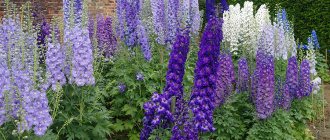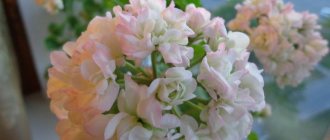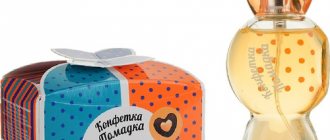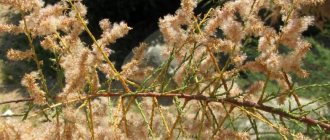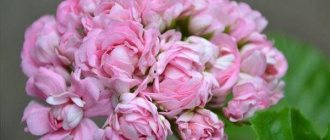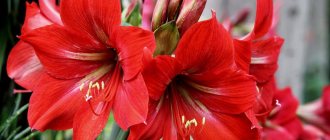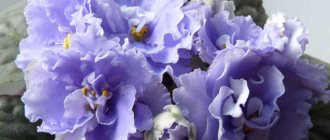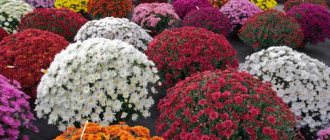Among flowering perennial and annual plants, delphinium has firmly taken an honorable place.
Its long, bright flowering cannot be ignored, and easy care of the plant does not cause difficulties even for inexperienced gardeners.
One thing: when working with a flower, you need to be careful, because delphinium is very poisonous.
Description of the plant
Larkspur, spur, delphinium (Delphinium) - all these are names of one plant. The herbaceous flower can be either perennial or annual.
Delphinium belongs to the Buttercup family and has about 450 species . Annuals are classified into a related genus called Sokirki (Consolida), which includes about 40 species.
The natural range of the spur is extensive; it can be found throughout the northern hemisphere on the edges of forests, clearings, along the banks of streams and rivers. Many varieties of larkspur are native to Southeast Asia.
Attention! Delphinium is closely related to the poisonous Aconite family and, like them, is poisonous.
The height of the plant ranges from 0.8 to 1.2 m, but the low-growing alpine delphinium does not grow higher than 10 cm.
The stem of delphinium is oriented strictly upward, rigid, unbranched. Depending on the variety, it may have pubescence or be smooth.
The leaf plates of the plant are palmate-pinnate, planted on thick petioles opposite each other in such a way that they form a kind of rosette. The edge of the leaf has pronounced serrations. The root system of the spur is developed, the root itself is thick and fibrous.
During flowering, the delphinium opens many buds , forming a long (sometimes up to 1 meter) flower cluster.
There is an opinion that when closed, the buds of the spur are similar to the head of a dolphin, which served as the basis for the name. According to the second version, the flower was named after the Greek city of Delphi, where it grew in huge quantities.
its second name - “spur” - due to the long transverse process on the sepals, which resembles a spur.
The color of the buds is strikingly diverse. Main shades:
- white;
- blue;
- blue;
- pink;
- yellow;
- violet.
The corollas are found in both rich and pastel colors, and the hybrid delphinium can have a two-color color.
Flowering begins in June-July and lasts until the end of September . Cultural delphinium - honey plant; has simple, semi-double or double flowers. They attract a large number of butterflies and bumblebees to the site.
Delphinium after flowering
When the leaves of a faded plant dry out, the shoots should be cut to a height of 30–40 centimeters from the ground surface. In this case, it is recommended to coat the top of the hollow shoot with clay, which will prevent liquid from entering it and the formation of rot in the root system. Almost all types of delphinium are frost-resistant (both young and adult specimens). If the winter period is little snow and frosty, then the delphinium should be covered with straw or spruce branches. Delphinium can die only from frequent and sudden changes in temperature, as high humidity appears and it rots. To prevent stagnation of water in the soil, pour ½ of a bucket of sand into the bottom of the planting hole during planting.
Types and varieties with photos
In the wild in Russia, two species of spurs are found, but many hybrid varieties of the plant are grown in gardens.
Garden
Perhaps, plants of this particular hybrid group are most often found in gardens and summer cottages . Most of the plants fall under the description:
- slender, vertically oriented flower with a height of about 2 m;
- flowering begins in June and lasts until September;
- very rarely double flowers, often with simple petals;
- the corollas are collected in spectacular cluster inflorescences, whose length can approach 100 cm.
Among garden delphinium hybrids there are several groups:
- elatums, or Foster group;
- Marfinsky hybrids (Malyutinsky varieties);
- pacific, or Pacific hybrids;
- belladonna;
- Delphinium Scottish, or Highlander.
High
This spur is found in the wild and has become the basis of many hybrids. The height of the plant usually stops within one and a half meters, less often it approaches the two-meter mark.
5–7 strongly dissected leaf plates are formed on the stem, and the inflorescence is a brush of ordinary non-double flowers of an azure or violet tone. Flowering, starting in mid-summer, will last until the end.
Tatransky
A relict plant, but at the same time it crosses well with a tall variety of delphinium, forming attractive hybrids.
The stem height is from 0.5 to 1 m, flowering occurs in July. The color of the petals has shades of azure and purple.
Large-flowered
Under natural conditions, plants of this group can be found in China and Russia, which is why they are called Chinese or Siberian spurs.
The maximum height of the shoot is about 100 cm, but most often the common-flowered delphinium does not exceed 0.5 m.
Magnificent large flowers of white, purple or light blue appear on the plant in June and bloom for about a month.
Sometimes a second flowering occurs in September. The buds do not form a pronounced inflorescence; they are located randomly on the stem.
Bruno or Brunona
This dwarf variety of larkspur rarely reaches 0.4 m in height. The perennial flowers are notable for their smooth transition from purple to blue.
Flowering occurs in the first months of summer, but delphinium bruno is able to bloom for the second time in September.
Interesting! When flowering, the plant emits a distinct musky aroma, for which it is popularly known as musk spur.
Holostalked
A dwarf species, whose height is in the range of 0.3–0.6 m. Under natural conditions, it is found in America.
The flowers of the holostem spur bear little resemblance to the flowers of other species; they differ in their more elongated tubular shape and the reddish-orange color of the petals. Flowering, starting in June, will last until the very beginning of autumn.
Delphinium ajax, or garden sokiriki
Plants of this species are annual hybrids of dubious and oriental spurs. The height of the shoots varies depending on the characteristics of a particular variety, ranging from 0.3–1 m in height.
Flowers can be either simple or densely double. The color of the petals is white, blue, pink, red or blue.
Delphinium field
Widely distributed in nature, it has served as the basis for many varieties and hybrids. The slender vertical stem of the field delphinium can reach a height of 2 meters.
The upper part of the stem is densely covered with single or double flowers, whose petals are colored white, pink, lilac, blue or violet.
The flowering period covers almost the entire summer and often extends to the beginning of autumn. It has been grown as a cultivated flower since 1572.
Delphinium care
After the plant stems grow to 10–15 centimeters, it will be necessary to fertilize with a solution of cow manure (for 5 adult bushes, mix 100 liters of water with 1 bucket of fertilizer). After weeding and loosening the soil, sprinkle its surface with a layer of mulch (peat or humus) which should be about 3 centimeters. After the shoots grow to 20–30 centimeters, it is necessary to thin out the bushes. So, you need to select from 3 to 5 strong stems, and remove the rest, while the inflorescences will become much larger and more spectacular. Less strong stems must be removed, and they must be broken off or cut off at the surface of the soil. This procedure also helps to protect the bush and provide better ventilation. Cuttings can be planted for rooting, but only those that are cut at the heel and are not hollow. It is necessary to treat the cut with a mixture consisting of crushed heteroauxin tablets and charcoal. The cuttings are planted in sand mixed with peat and covered with film on top. Rooting of the cutting will occur in 3–6 weeks, and after half a month it can be planted in open soil.
After the bush grows to 40–50 centimeters, you should carefully dig 3 slats (support rods) around it, the height of which should be 1.8 m. You need to tie the shoots of the plant to them, using strips or tapes of fabric, so In case of strong gusts of wind, they will not crash into the stem. When the shoot is 1–1.2 m high, it will need to be tied up a second time.
During the period of intensive growth, each bush requires approximately 6 buckets of water. If the summer period is dry, then 20–30 liters of water should be poured under each bush once every 7 days. After the soil has dried, its top layer must be loosened to a depth of 3 to 5 centimeters. When inflorescences form, the plants should be provided with good watering. If there is extreme heat during this period, gaps (areas with no flowers) may appear on the inflorescences. To prevent this, it is necessary to water the delphinium abundantly, and also feed it with phosphorus-potassium fertilizer (20 g of substance per 10 liters of water). Take 1 liter of nutrient solution per bush.
From mid-summer, delphinium may develop powdery mildew (a whitish coating appears on the foliage, turning brown over time). If there is delay, the entire part of the flower above the ground may die off. If there is a suspicion that the plant is infected, then it should be treated with a solution of foundationazole or Topaz (2 times at intervals). Black spots may appear on the leaves, spreading from the bottom of the bush to the top. So, black spotting appears. It can be cured only at the very beginning of its development. To do this, you need to treat the plant twice with a tetracycline solution (1 tablet per 1 liter of water). When ring spot appears, the leaf blades become covered with yellow spots. This viral disease is incurable; the flower must be destroyed as soon as possible. The carrier of this virus is aphids, and therefore, for preventive purposes, it is recommended to treat flowers with a solution of actellik or karbofos. An insect such as the delphinium fly lays eggs in the flowers of the plant, and the flowers can also be damaged by slugs. You can get rid of flies with insecticidal agents, and you can repel slugs with the help of jars placed between bushes and filled with bleach.
When flowering ends, the inflorescences need to be trimmed and, if necessary, collected seeds. Then young stems appear and re-blooming occurs in autumn. Between the 1st and 2nd flowering, you can divide the bush (in the last summer or first autumn days). In this case, the bush must be older than 3–4 years. The plant is dug up and carefully cut with a sharp knife or divided. At the same time, make sure that the renewal buds are not damaged. Treat the cuttings with wood ash and plant the cuttings.
Growing from seeds
Typically, plants are planted in the ground in the second half of May . However, in order for the delphinium to take root normally and enter the flowering season, it is appropriate to sow seeds for seedlings.
The timing of sowing seedlings is at the end of February - beginning of March .
Preparing seeds for planting
To improve seed germination, they must be pre-treated.
The seed disinfection phase should not be skipped. This will help prevent the development of fungal infections on adult delphiniums.
If seeds are purchased for planting in a store, then manufacturers indicate on the packaging whether the seeds have been disinfected or not.
In this case, if the manufacturer takes care of disinfecting the seed, then the seeds are simply soaked for a day in warm water with the addition of a growth stimulant .
Delphinium seeds collected from plants in the garden or bought from hand must be disinfected before soaking .
A fungicide solution is suitable for this (the dosage should be taken from the instructions for the product) or a dark pink solution of potassium permanganate. Just soak the seeds for 10–15 minutes, then rinse in running water.
Stratification and sowing of seeds
Stratification improves seed germination . For these purposes, a container with seeds can be buried in the snow, but the air temperature should not fall below -5 ° C.
It will be much safer to carry out the procedure in a household refrigerator. A couple of weeks before the planned planting in seedling containers, delphinium seeds are placed on a damp cloth and placed in a bag. The bag is stored on the vegetable shelf.
Caring for seedlings: how to grow correctly
Prepared seeds are sown in containers filled with nutritious loose substrate. You can take a universal soil and add sand to it , or make a soil mixture for delphinium yourself.
For this you will need:
- 2 parts leaf soil;
- 2 parts peat;
- 2 parts humus;
- 1 part coarse sand;
- 0.5 cups perlite.
Attention! A self-composed mixture must be poured with a strong solution of potassium permanganate or heated in the oven for disinfection.
The seeds are distributed over the surface of the soil and sprinkled with a small amount of substrate. Water with a spray bottle and cover with glass.
The glass is removed daily for a short time to ventilate and moisten the soil (as needed).
It is recommended to place the container with the crops on a well-lit windowsill, but cover it with dark cloth or film .
The sun's rays will help create the necessary greenhouse effect, and darkening will stimulate faster emergence of seedlings.
After the delphinium seedlings have appeared, the shelter is removed and the container is moved away from direct sunlight.
When 2–3 true leaves appear on the seedlings, the seedlings need to be planted into individual pots with a volume of at least 200 ml. Try to choose containers with a removable bottom or peat pots so as not to damage the roots when planting in the ground.
Features of delphinium
Growing this beautiful flower is quite difficult and for this you will need certain knowledge. As for choosing a site for planting, it must be illuminated by the sun before lunch and not be exposed to strong gusts of wind. It should also be placed in a place where there is no stagnation of water, as this may cause rot on the plant. When the plant is planted, the surface of the soil must be sprinkled with a layer of mulch (humus or peat). Such flowers can be cultivated in the same place for no longer than 5–6 years, while Pacific species can be cultivated for no more than 3–4 years. After this, the bushes need to be dug up, divided and planted. Their hollow shoots need to be tied up several times a season, because they can be injured by gusts of wind. This plant can get powdery mildew, and harmful insects can also live on it. If you care for the delphinium correctly, you can admire its spectacular and quite abundant flowering in June. The plant blooms a second time in August or September, but this time the flowering period does not last long.
How to grow delphinium from seeds. Website "Garden World"
Planting and care in open ground
Planting a delphinium in a permanent place does not present any particular difficulties, but the choice of location and further care have a number of nuances .
How and when to plant a plant
Planting in the ground is carried out only after the threat of return frosts has completely passed , i.e. in the second half of May. To plant delphinium, the flower bed is prepared in advance:
- the ground needs to be dug up;
- loosen;
- remove weed roots;
- prepare the holes.
The distance between the holes is at least 0.5 m . The depth of the planting pit is about 0.4 m with the same diameter.
Soil for a flower
The soil in the flowerbed should be loose and nutritious. In many ways, this is why such volumes are laid for the planting hole, because it is almost completely filled with a ready-made substrate from a mixture of garden soil, humus, 30 g of complex fertilizer and 200 ml of wood ash .
The substrate is thoroughly mixed and poured into the hole. A depression is made in the loose soil, and a spur seedling is planted in it.
For the first time, it is recommended to cover the delphinium seedlings with a cut plastic bottle or glass jar. Such a mini-greenhouse will facilitate the process of rooting and adaptation.
Landing site requirements
In many ways, the success of growing spurs in the garden depends on the right location. Given the size of an adult plant, it will need protection from sudden gusts of wind or good support .
In addition, the site should not be located in a low area where moisture can accumulate - this will lead to the development of root rot or fungal infections.
Another requirement of the delphinium is the absence of direct sunlight in the afternoon . The fact is that excess ultraviolet radiation will lead to fading of the bright colors of the petals.
But it’s also not worth pushing the spur into the shade completely. It is optimal to plant the flower in such a way that the sun's rays illuminate the plant in the morning or at sunset.
Which neighbors to choose for delphinium
Delphinium has certain requirements for the planting site; accordingly, representatives of the flora whose preferences are close to these conditions .
Good neighbors for delphinium will be:
- lupine;
- mallow;
- day-lily;
- rudbeckia;
- phlox.
How to replant delphinium
Perennial specimens need to be moved to a new location from time to time . Transplantation is carried out in spring to mid-May or in autumn (September - early October).
If the delphinium is sick, then the transplant is carried out at any time, since this is a forced measure, aimed at saving the flower.
Watering and fertilizing
The spur is not too demanding when it comes to watering, but on average it should receive about 60 liters of water during the growing season .
If the summer is dry, at least 10 liters of water are poured under each bush twice a week. If there is frequent precipitation, the amount of watering is reduced.
The delphinium is fertilized about a month after planting with organic matter . To do this, prepare an infusion of 100 liters of water and a bucket of cow dung - this amount is enough for 5 plants.
By the time the inflorescences form, potassium-phosphorus complexes are added according to the instructions.
Trimming
Delphinium pruning is carried out when the bushes grow to a height of 0.3 m . You need to leave only 5–7 of the strongest shoots, cut the rest close to the ground level.
Care after flowering, preparation for winter
To prepare for winter, it is important to properly prepare the delphinium when the inflorescences have faded. The stems are cut to a height of 0.3 m.
The stem of the spur is hollow, therefore, in order to prevent moisture from getting inside and rotting the stem, the cut site must be coated with clay.
To protect the stems from temperature fluctuations, you can cover them with spruce branches or straw . Otherwise, the delphinium does not require special shelter, since it tolerates frost well.
Caring for delphinium in the second year
The spur grass is actively growing after wintering. It requires a sufficient amount of moisture, and for the development of healthy shoots, you need to cut off new shoots, leaving only 3-5 of the strongest ones .
To make the delphinium grow faster, it is fed with nitrogen-containing fertilizers.
Delphinium in landscape design
In landscape design, the spur is universal. It is grown in gardens of various types: urban and rural, eastern and forest. The plant is planted along fences, architectural objects and walls. Tall varieties are used as a background for low-growing plants. Low hybrid varieties are suitable for growing in containers - they decorate terraces, balconies, and roofs.
Delphiniums of different varieties combine perfectly with each other. They look beautiful with peonies, sunflowers, lilies, geraniums, chrysanthemums and other garden crops. Originally combined with roses.
It is impossible not to notice a delphinium in a flowerbed, even if there are roses growing next to it. Beautiful perennial inflorescences will make any corner of the garden bright and spectacular.
Pest and disease control
Spurs suffer from powdery mildew . Treatment with a fungicide will help cope.
Black spot can be defeated only at the very beginning of the development of the disease; if most of the bush is affected, it will not be possible to save the flower.
Among the pests that pose a danger to delphinium are:
- aphid;
- delphinium fly;
- slugs
Insecticide treatments will help destroy aphids and flies, but slugs can be lured into special traps.
Thinning and pruning
After the flowers fall, the perennial delphinium is prepared for winter. All shoots are cut very low from the ground, the “stumps” are hilled up and covered with earth so that water does not get into the hollow stems.
In the second year of flowering, the delphinium bush produces new shoots, and they must be removed, otherwise the flowering will not be dense. Cut off the weaker stems, leaving 20-25 cm. It is recommended to leave no more than 5 shoots on the bush.
Abundance
Spurs or larkspur, as these flowers are also called, breeders know more than 800 species and varieties. They have large double or semi-double flowers with a diameter of 1.5 to 10 cm in white, blue, various shades of blue and lilac, pink, red, purple, dissected leaves located on stems 40 to 200 cm high.
Conventionally, all perennials can be grouped into groups, the names of which come from the geography of their origin.
New Zealand - a numerous and very popular community of disease-resistant tall (up to 2 m long) shoots with unusual petals, characterized by a long flowering period and unpretentiousness. They store well for a long time after cutting.
Scottish - subspecies with dense inflorescences of rich colors, occupying almost half the length of the stem.
Marfinskie (named after the state farm where they were bred) are low-growing, frost-resistant hybrids with contrasting colors and huge fluffy flowers decorated with spots resembling “eyes.”
Unfortunately, these varieties cannot be reproduced using seeds.
Problems
Spurs are harmed by aphids, mites, cutworms and thrips, and insecticidal preparations will help get rid of them.
Main diseases:
- powdery mildew,
- black or ring spot,
- root rot.
For treatment, industrial fungicides or a solution of potassium permanganate are used. But it is better, of course, to carry out preventive measures, avoiding the manifestation of diseases.
We hope that our photos and videos of perennial delphinium will explain the features of planting and care, and the graceful flowering columns will undoubtedly become a decoration for your flower garden.
Care
High varieties are grown mainly in open ground. To do this, they are placed next to buildings or fences, or surrounded by supporting supports. The landing site must be selected in such a way that it is protected from the wind, otherwise sharp gusts will break the fragile branches.
Spur prefers neutral soils with good drainage, since due to the superficial location of the rhizome in wetlands it can die.
A few weeks before transplanting, the seedlings begin to harden, for which they are taken outside daily, first for 15-20 minutes, and then the duration of their stay in the fresh air is gradually increased.
When it’s time to plant seedlings in the garden, mineral fertilizers, such as phosphorus-potassium fertilizers, are added to prepared holes so that additional nutrition alleviates stress.
During the summer season, fertilizing is repeated two more times, which significantly extends the flowering period and makes it possible to prepare for overwintering.
For abundant flowering, seedlings need sunlight, but they do not tolerate daytime heat well. It is advisable that on a hot afternoon they be covered from the sun with tree branches or a special net.
Regular removal of faded petals stimulates the formation of new buds.
Despite the fact that the perennial can easily withstand winter frosts of 40 degrees, it is important to properly prepare it for winter. To do this, in late autumn it is cut off almost at the base and hilled up, or protected with a cut plastic 5-liter jar so that water does not get into the hollow branches.
Larkspur can be cultivated on one site for no more than 4-5 years, after which it should be transplanted.
All elements of the plant contain an alkaloid that is toxic to humans, which, if ingested, can cause gastrointestinal disorders and dermatitis. And in the Middle Ages they were used to make protective amulets and amulets against the evil eye.
